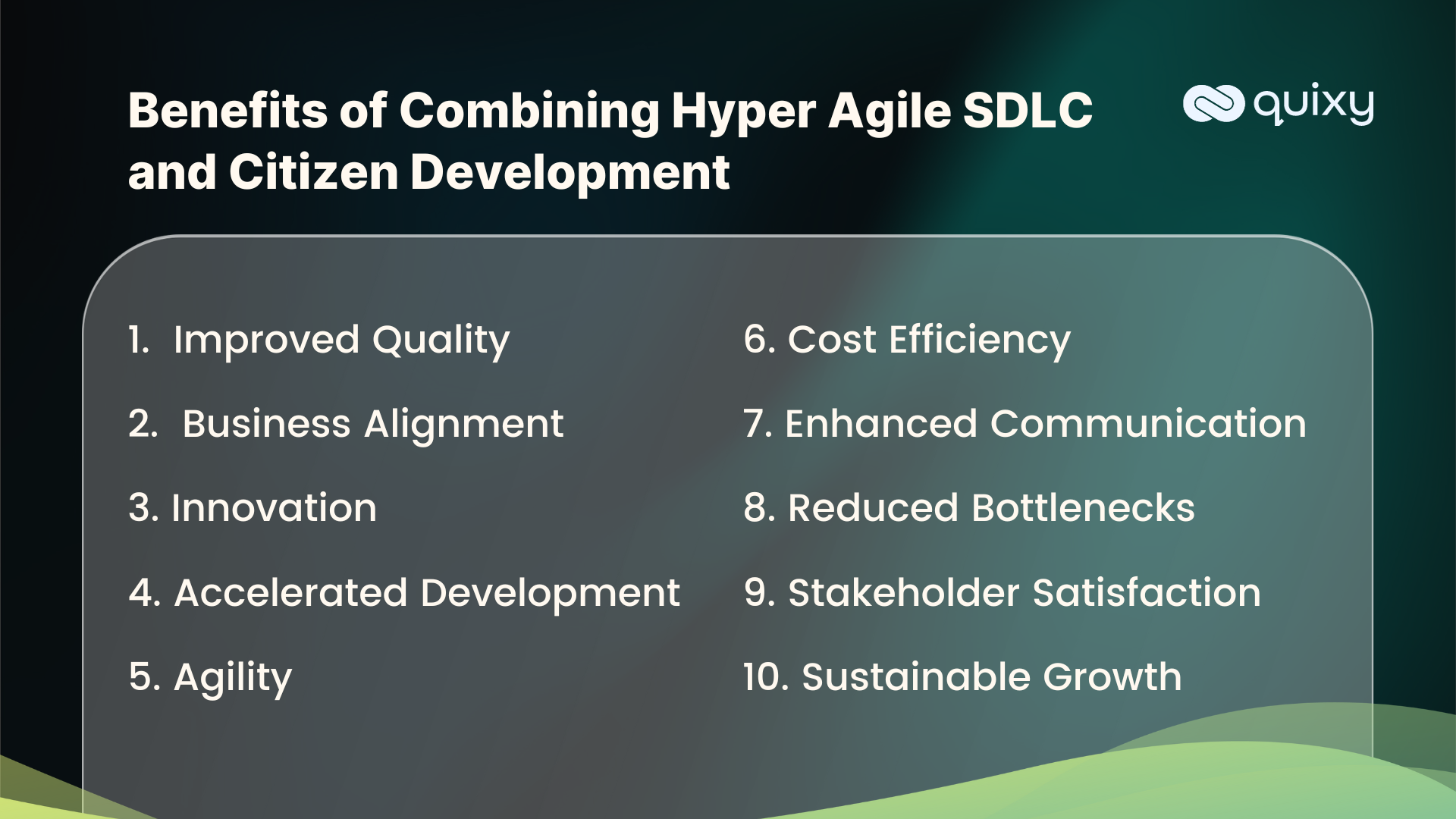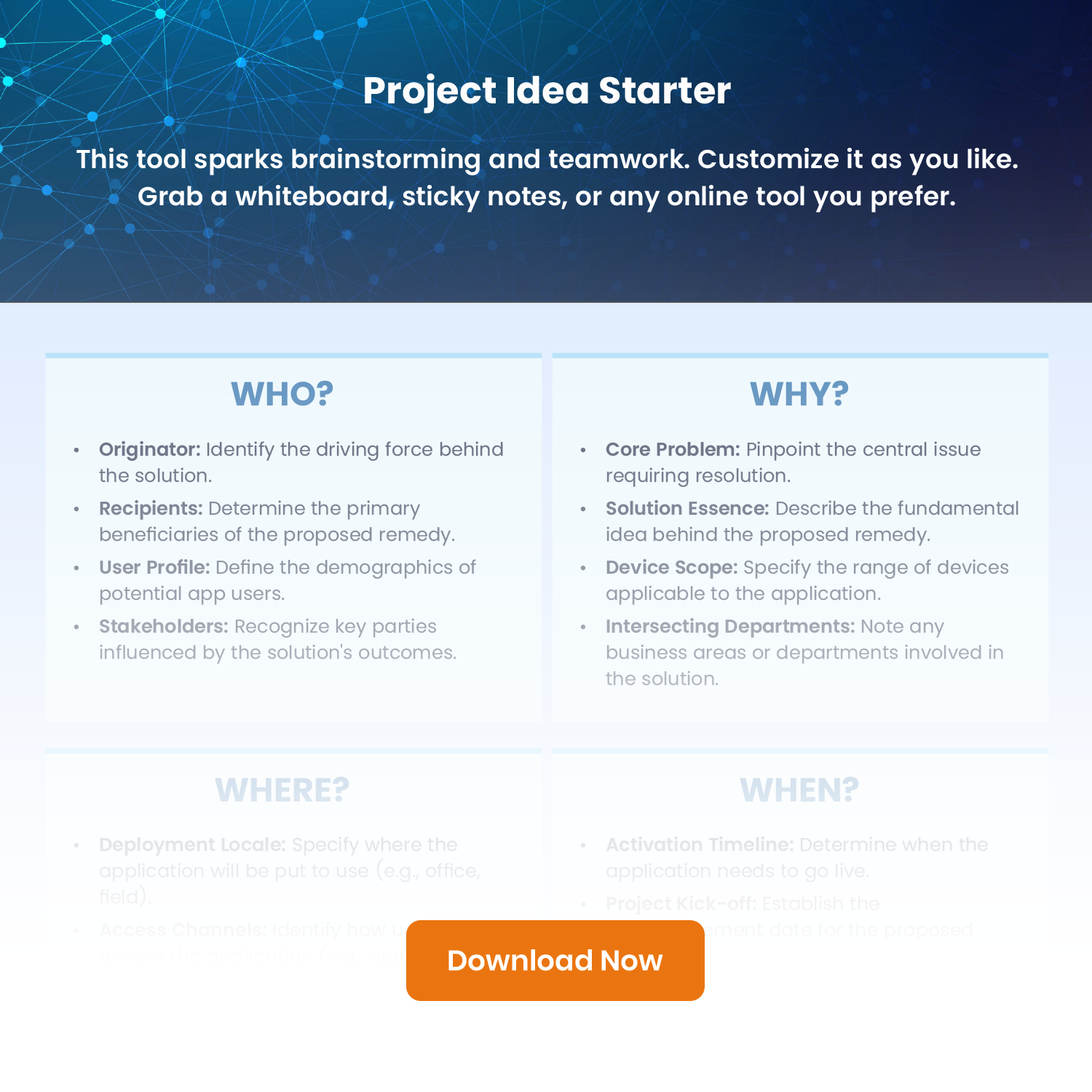
Hello, tech enthusiasts! Curious about supercharging your software development? Buckle up, as we explore the Hyper Agile SDLC and Citizen Development. These cutting-edge approaches propel your projects to new heights. Hyper Agile SDLC emphasizes rapid iterations and adaptability, while Citizen Development empowers non-developers to create solutions. Get ready to unlock innovation and efficiency in your software endeavors! Turbocharge your software development process with Hyper Agile SDLC and Citizen Development.
What is Software Development Life Cycle?
Imagine a software development process that delivers unparalleled quality, minimizes costs, and accelerates timelines to the maximum extent possible. That’s the essence of the Software Development Life Cycle (SDLC), a methodical approach that guides organizations in rapidly crafting top-tier, well-tested software, ready for real-world use.
But what sets the Hyper-Agile SDLC apart from the rest?
- Convergence of Design and Development: It seamlessly merges design and development into a single, cohesive activity. No more extensive requirement gathering, endless handoffs, or excessive documentation.
- Leaner Teams, Real-Time Progress: Smaller teams, real-time development, and reduced governance mean less managerial overhead and increased delivery capacity within your organization.
In the upcoming section, we’ll delve into the three distinct decision pathways to delivery, all grounded in the complexity and risk associated with crafting the perfect solution.
Definition: Agile
In software development, agile practices reign supreme. They revolve around collaborative efforts by self-organizing, cross-functional teams and their customers/end users. Agile champions adaptive planning, evolutionary development, early delivery, and continual improvement, all while embracing the flexibility to respond to change
What is Hyper Agile SDLC?
So, picture this: you’ve got a software project, and you want it to zoom ahead at warp speed while maintaining top-notch quality. That’s where Hyper Agile SDLC comes into play. It’s like Agile on steroids, focusing on rapid iterations, constant collaboration, and delivering maximum value to your users.
Also Read: SDLC Vs Agile: Which one is the best?
Understanding Citizen Development in Software Development
Now, here’s the twist. Citizen Development isn’t about capes and secret identities—it’s about empowering non-techies within your organization to be part of the software development process. It’s a revolution that bridges the gap between IT and business users, fostering innovation and agility.
Benefits of Combining Hyper Agile SDLC and Citizen Development

Imagine a world where your software development happens faster, with more collaboration, and is always aligned with your business needs. That’s your dream team of Hyper Agile SDLC and Citizen Development. Buckle up; we’re about to explore how this dynamic duo can transform your projects. Here are a list of benefits-
- Speed: Faster software development.
- Collaboration: Enhanced teamwork.
- Alignment: Business needs are always met.
- Innovation: Fresh ideas.
- Responsiveness: Quick adaptations.
- Cost Savings: Efficient resource utilization.
- Diverse Skills: Comprehensive expertise.
- Continuous Improvement: Ongoing enhancements.
- Reduced Backlog: Smaller IT task queue.
- Empowerment: Increased workforce morale.
- Time-to-Market: Quicker product launches.
- Flexibility: Adaptability to change.
Choosing the Suitable SDLC Path
The Hyper-Agile SDLC accommodates projects of varying ambition, scale, and complexity. The decision point, the IT spot assessment, determines the project’s path based on risk and technical complexity. There are three primary pathways within the Hyper-Agile SDLC:
- Fast Track: The fast track path is the choice for projects considered low risk and low in technical complexity. It emphasizes iterative ideation, design, build, and deployment with continuous feedback loops from the business.
- Assisted Path: The assisted path comes into play for initiatives with medium technical complexity and low risk. Citizen developers can seek support from the competency center, enabling them to progress efficiently while engaging with technical experts when necessary.
- IT Delivery Path: Projects with high risk or technical complexity follow the IT delivery path. While IT control becomes necessary at this stage, citizen developers remain involved, utilizing IT policies, standards, and resources to ensure successful delivery.
The choice of SDLC path hinges on two critical variables: risk and technical complexity. Projects falling within the low to medium range for both variables are prime candidates for citizen development. On the other hand, high-risk or highly complex projects are best suited for traditional IT approaches.
However, it’s important to note that the boundaries between these categories are not rigid. Organizations can exhibit varying risk tolerance levels, and what may be considered high technical complexity for one organization could be manageable for another.
Also Read: Solving SDLC Pain Points with No-Code
Hyper Agile SDLC Path Tasks
Businesses require a software development life cycle (SDLC) that can adapt quickly to changing requirements and market dynamics. Enter the Hyper Agile SDLC Path, a streamlined approach that combines agility, innovation, and efficiency to deliver software solutions that meet the demands of the modern world. Here are the key tasks and stages within the Hyper Agile SDLC Path:
1. Design
The design phase is where the foundation of the software solution is laid out. It involves creating the architectural blueprints, user interfaces, and overall system design. In the Hyper Agile approach, design is not a one-time activity but an ongoing process that evolves with the project.
2. Build
Building involves the actual coding and development of the software. In a Hyper Agile SDLC, this is done iteratively and incrementally, with small, frequent releases. Developers collaborate closely with designers to ensure that the software aligns with the initial design.
3. Deploy
The deployment phase marks the transition from development to production. Hyper Agile emphasizes continuous integration and continuous deployment (CI/CD) practices, enabling rapid and automated deployment of new features and updates.
4. Support
Providing ongoing support is crucial in the Hyper Agile SDLC. This involves monitoring the software in production, promptly addressing issues, and ensuring the system runs smoothly. Feedback from users and monitoring tools drive continuous improvements.
5. Change Management
Change management is an integral part of Hyper Agile SDLC. It involves managing and controlling changes to the software throughout its lifecycle. Change requests are evaluated, prioritized, and integrated into the development process as needed.
6. Business Analysis Design
This task involves a deep dive into understanding the business requirements and objectives. It helps align the software development efforts with the strategic goals of the organization. Business analysts play a pivotal role in this phase.
7. Detail Assessment
Before diving into development, a detailed assessment is conducted. This includes defining user stories, refining requirements, and estimating the effort required for each task. This ensures that development efforts are focused on the most valuable features.
8. IT Delivery
IT delivery is the culmination of the Hyper Agile SDLC Path. It involves delivering a software solution that meets the business needs, is of high quality, and is responsive to changes in the market. Frequent deliveries ensure that the software remains relevant and competitive.
The Hyper Agile SDLC Path is a dynamic and responsive approach to software development that prioritizes collaboration, flexibility, and customer feedback. It acknowledges that change is constant, and by embracing it, organizations can stay ahead of the curve and deliver software that truly adds value to their business. Whether you’re designing, building, deploying, supporting, managing change, conducting business analysis, assessing details, or delivering IT solutions, the Hyper Agile approach ensures that your software development process is agile, efficient, and adaptable.
The Importance of Project Ideation in Hyper Agile SDLC
1. Project Initiation and Spot Assessment
Starting with a clear project Idea is vital before starting your software development journey. Think of it as setting the GPS coordinates for your adventure—it keeps you on the right path.
2. Purpose of Assessment After Project Initiation
Assessment isn’t just about checking boxes; it’s your early-warning system. It helps you identify potential roadblocks and bottlenecks, ensuring a smoother ride ahead.
3. Identifying Issues and Areas for Improvement
In Hyper Agile SDLC, we constantly improve. Spot assessment shines a spotlight on areas that need a little TLC, driving your project to new heights.
4. Significance of Having a Clear Project Idea
Imagine building a complex puzzle without knowing what the picture looks like. That’s why a clear project concept is your guiding light, ensuring everyone is on the same page.
5. Addressing Complexities in Project Ideation
Let’s face it; not all projects are a walk in the park. Hyper Agile SDLC equips you to tackle complex challenges like a pro. It’s like having a Swiss army knife for software development.
Before starting a project, it’s essential to have a plan in place. That’s where a structured project idea starter worksheet can help you brainstorm ideas and tackle challenges effectively.
Also Read: Accelerating Innovation with Agile Idea Development
Project Idea Starter Worksheet
Struggling to Kickstart Your Project? Wondering How to Craft Clear Objectives? Meet Our Project Idea Starter Worksheet! It is a structured framework for brainstorming and organizing project concepts, objectives, and essential details. This valuable tool helps teams and individuals refine their project ideas, ensuring a clear and well-defined starting point for successful project execution.

The Role of Project Idea Starter Worksheet
- Creating a Project Idea Worksheet: Ever had a brilliant idea but struggled to put it into words? The Project Idea Starter Worksheet is your trusty sidekick, helping you articulate your vision clearly.
- Utilizing the Worksheet to Define Project Scope and Objectives: In software development, clarity is king. The worksheet streamlines defining your project’s scope and objectives, ensuring everyone’s on the same wavelength.
- How the Project Idea Worksheet Facilitates Collaboration: This worksheet can be your secret weapon in a world where communication is key. It bridges the gap between techies and non-techies, ensuring everyone speaks the same language.
- Enhancing Communication and Understanding Among Stakeholders: The Project Idea Worksheet ensures everyone’s on the same page, making those important conversations a breeze. Keeping you in constant touch with your stakeholders.
Benefits of Project Idea Worksheet: Collaboration between Citizen Developers and Initiators
1. Receiving and Evaluating the Project Proposal
Picture this as the moment of truth. Project Idea worksheet will guide you through receiving and evaluating project proposals, helping you make informed decisions.
2. Meetings and Communication for Clarification and Discussion
Effective communication is the glue that holds successful collaborations together. The project ideation worksheet unravels the best practices for fostering clear communication through meetings and discussions.
3. Leveraging Citizen Developer Expertise in Solution Ideation
Citizen Developers aren’t just spectators; they’re MVPs. Harness their unique perspectives during the ideation phase.
4. The Role of Citizen Developers in Shaping the Project Idea
Citizen Developers don’t just sit on the sidelines; they actively shape project Ideas. They can help in crafting a winning game plan with practical insights and concerns.

Hyper-Agile SDLC in Practice
A Game-Changer for Business Autonomy
Businesses constantly seek innovative approaches to streamline project delivery, reduce bottlenecks, and enhance agility. Enter the Hyper-Agile Software Development Life Cycle (SDLC), a revolutionary methodology that champions business autonomy and empowers citizen developers to lead ideation, prototyping, and more. In this comprehensive guide, we delve into the intricacies of the Hyper-Agile SDLC, its guidelines, and how it can reshape your approach to application development.
Embracing Business Autonomy
The foundation of the Hyper-Agile SDLC lies in putting business autonomy at the forefront of project initiation. Traditionally, businesses had to navigate a labyrinth of IT stage-gate approvals, extensive project charters, and administrative controls before even reaching the prototyping stage. However, with the Hyper-Agile SDLC, these barriers are dismantled, allowing businesses to retain autonomy for ideation and solution design.
Transition to Support and Change Management
In the Hyper-Agile SDLC, citizen developers collaborate with business teams to establish a support and change management framework while developing software. This agile framework includes defining responsibilities, support processes, and ongoing maintenance procedures. Typically, citizen developers handle application setup and daily operations, while IT experts manage the technical backend, such as databases and integrations. Maintenance tasks are categorized into four types: corrective (fixing issues), adaptive (adjusting to changes), perfective (making improvements), and predictive (proactive upkeep). It’s important to note that enhancements trigger a return to the software development cycle for further improvements and planning.
Also Read: Citizen Development Can Pave the Way For Agility
Guidelines for Citizen Development Project Delivery
To successfully implement the Hyper-Agile SDLC, it’s crucial to adhere to a set of guidelines tailored to the unique demands of citizen developers:
1. Minimal IT Approvals
Citizen developers operate with the least reasonable number of IT stage-gate approvals. This streamlined process minimizes unnecessary bureaucracy and fosters rapid progress.
2. Understanding IT Control
Citizen developers are responsible for understanding the purpose and benefits of IT control. They should consult IT when necessary, ensuring alignment with organizational IT policies and standards.
3. Freedom from Lengthy Charters
Gone are the days of laboring over extensive project charters. Citizen developers are liberated from administrative controls, allowing them to focus on what truly matters: bringing innovative ideas to life.
4. Streamlined Documentation
The Hyper-Agile SDLC prioritizes action over paperwork. Minimum documentation is required, promoting efficiency and reducing overhead.
5. Unleash Creativity
Citizen developers are granted broad freedom to ideate and prototype. This creative liberty fuels innovation and accelerates the development process.
6. Early Consideration of Business/Operational Risk
A core tenet of the Hyper-Agile SDLC is the early consideration of business and operational risk. This proactive approach ensures that potential pitfalls are addressed from the outset.
7. Parallel Design and Implementation
Unlike traditional SDLCs, where design and implementation are sequential, the Hyper-Agile approach encourages concurrent operating model development alongside application design. This parallelism enhances efficiency and agility.
8. Commitment to Quality Assurance
Citizen developers are bound to uphold quality assurance, resilience, and security controls, ensuring the final product meets high standards.
Collaboration with IT Developers: Citizen developers enlist the support of IT developers when it’s deemed appropriate, fostering a symbiotic relationship between business and IT.
Future Trends and Considerations
Get ready for a thrilling ride through the ever-evolving world of Hyper Agile methodologies! We’re about to dive headfirst into the latest and greatest advancements in this dynamic field, where new frameworks and groundbreaking tools are reshaping the future of software development. But that’s just the beginning.
Imagine a world where artificial intelligence (AI) and automation aren’t just buzzwords but the driving forces behind the future of the Software Development Life Cycle (SDLC). We’ll unlock the secrets of how AI-powered tools are turbocharging development, supercharging testing, and completely revolutionizing maintenance. You won’t just hear about it; we’ll take you on a journey through real-world examples, showing you how to harness AI’s mind-blowing potential for your own projects.
But wait, there’s more! As Citizen Development gains momentum, we’ll pull back the curtain on this movement’s ethical and social implications. It’s a candid conversation about data security, privacy, and the profound responsibility that comes with empowering non-techies to join the software development party. We’re about to embark on a thought-provoking journey deep into the intersection of technology and ethics.
Conclusion
The Hyper-Agile SDLC represents a paradigm shift in software development, placing business autonomy and citizen developers at the forefront. By embracing this innovative methodology and adhering to its guidelines, organizations can accelerate project delivery, reduce red tape, and foster a culture of innovation.
In a rapidly evolving digital landscape, the Hyper-Agile SDLC is a game-changer, enabling businesses to stay ahead of the curve and respond swiftly to changing market dynamics. Embrace the future of software development and empower your citizen developers with the Hyper-Agile SDLC.
The future of software development is a bright horizon. Embracing Hyper Agile SDLC and Citizen Development positions you for success in the ever-evolving tech landscape. So, continue to innovate, collaborate, and make waves in the world of software development.
But let’s not stop here. Let’s push the boundaries further:
- Imagine software development at quantum speed, powered by quantum computing and algorithms. Stay tuned as we explore this game-changing realm.
- Citizen Development is on the horizon, empowering organizations with no-code and low-code platforms and democratizing software development.
- As AI’s role in SDLC grows, so do the ethical concerns. We’ll delve into the moral imperative of AI ethics in software development.
- Hyper Agility isn’t just about speed but agility and resilience. Explore how it evolves to meet the ever-changing tech landscape.
- Citizen Development Communities are rising, fostering collaborative innovation and pushing the boundaries of what’s possible.
Remember, your journey as a software developer is an ongoing adventure. The tech world keeps evolving, and you have a pivotal role in shaping its future. Stay curious, stay innovative, and be ready to embrace the next wave of technological advancements. The possibilities are limitless.
Frequently Asked Questions(FAQs)
Q. What defines Hyper Agile SDLC?
Hyper Agile SDLC is an advanced software development approach characterized by its emphasis on rapid iteration, adaptability, and collaboration. It builds upon traditional Agile methodologies but focuses more on short development cycles and real-time responsiveness to changes. Hyper Agile teams prioritize delivering functional software quickly, continuously improving their processes, and working closely with stakeholders to achieve the highest value.
Q. How can Citizen Development enhance projects?
Citizen Development empowers individuals without formal programming backgrounds to create applications using no-code or low-code platforms. This democratizes the development process, accelerates project timelines, and fosters innovation. It enables non-developers to contribute their domain expertise directly to software creation, reducing dependency on IT teams and promoting efficiency throughout the organization.
Q. What are the fundamental principles for Hyper Agile success?
Hyper Agile success hinges on several core principles. These include a commitment to continuous improvement, a strong emphasis on customer collaboration and feedback, and the consistent delivery of functional software. Additionally, it encourages teams to remain adaptable and responsive to changing requirements, prioritize individuals and interactions over processes and tools, and focus on delivering value to the customer.
Q. What challenges may arise in Citizen Development?
Implementing Citizen Development can pose challenges, such as ensuring data security and compliance with organizational policies. It’s crucial to strike the right balance between empowering non-developers and maintaining control over critical systems. Organizations must also provide adequate training and support to citizen developers to ensure the quality and reliability of the applications they create.
Q. How to stay informed with the latest Hyper Agile and Citizen Development trends?
To stay updated on these evolving trends, consider following reputable industry blogs, attending conferences, and participating in online communities dedicated to Hyper Agile and Citizen Development. Engaging with experts, networking with peers, and reading relevant literature can provide valuable insights into emerging practices, tools, and best practices in these fields.
Subscribe
Login
Please login to comment
0 Comments
Oldest















